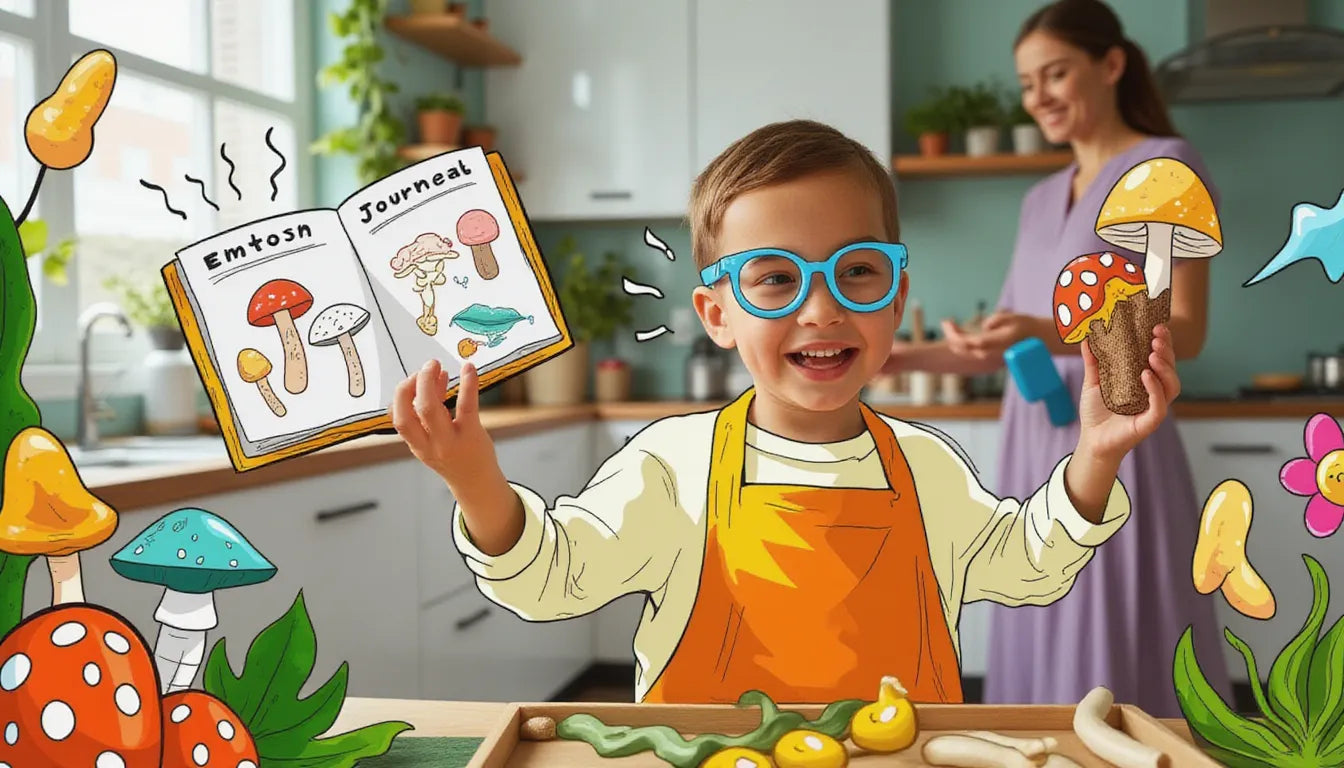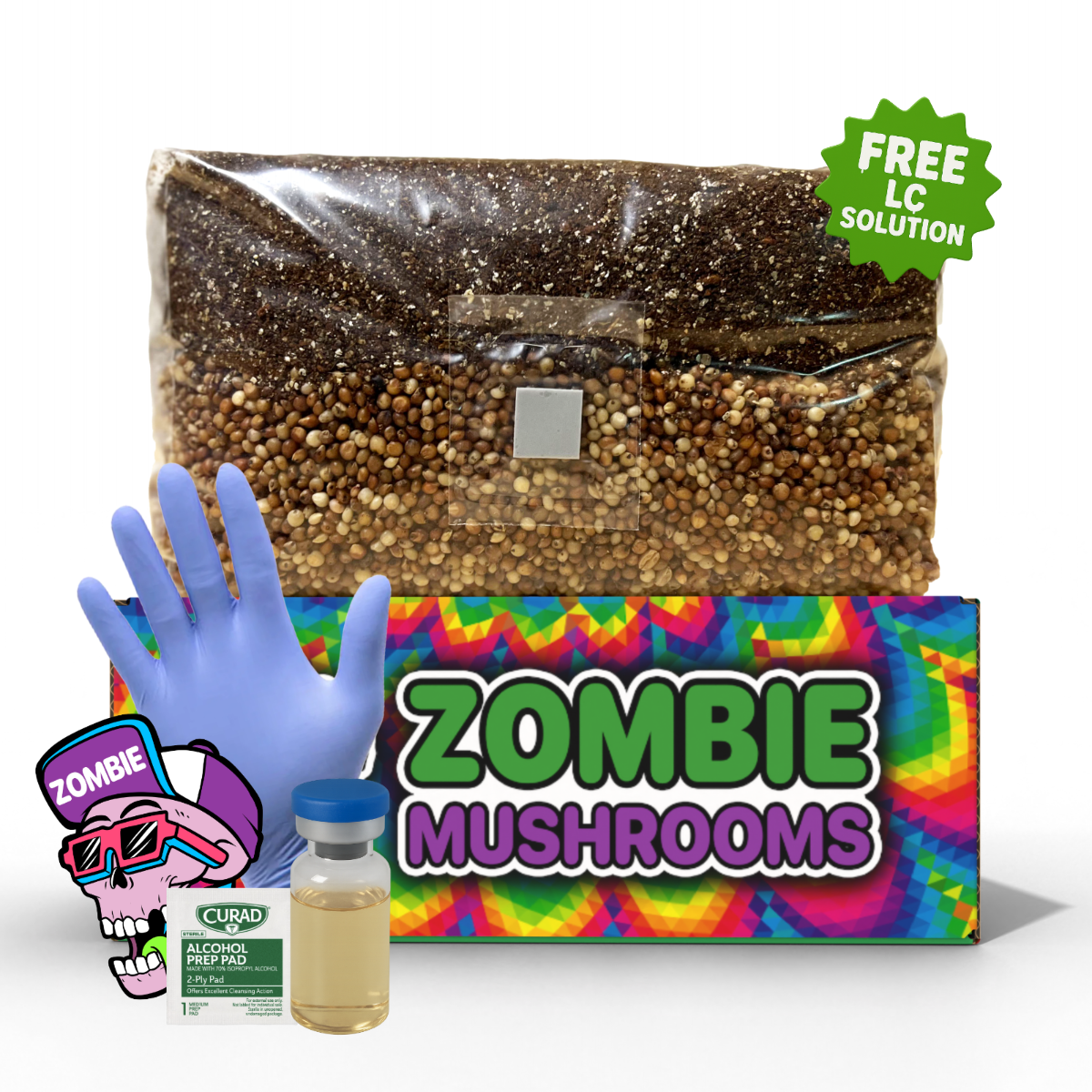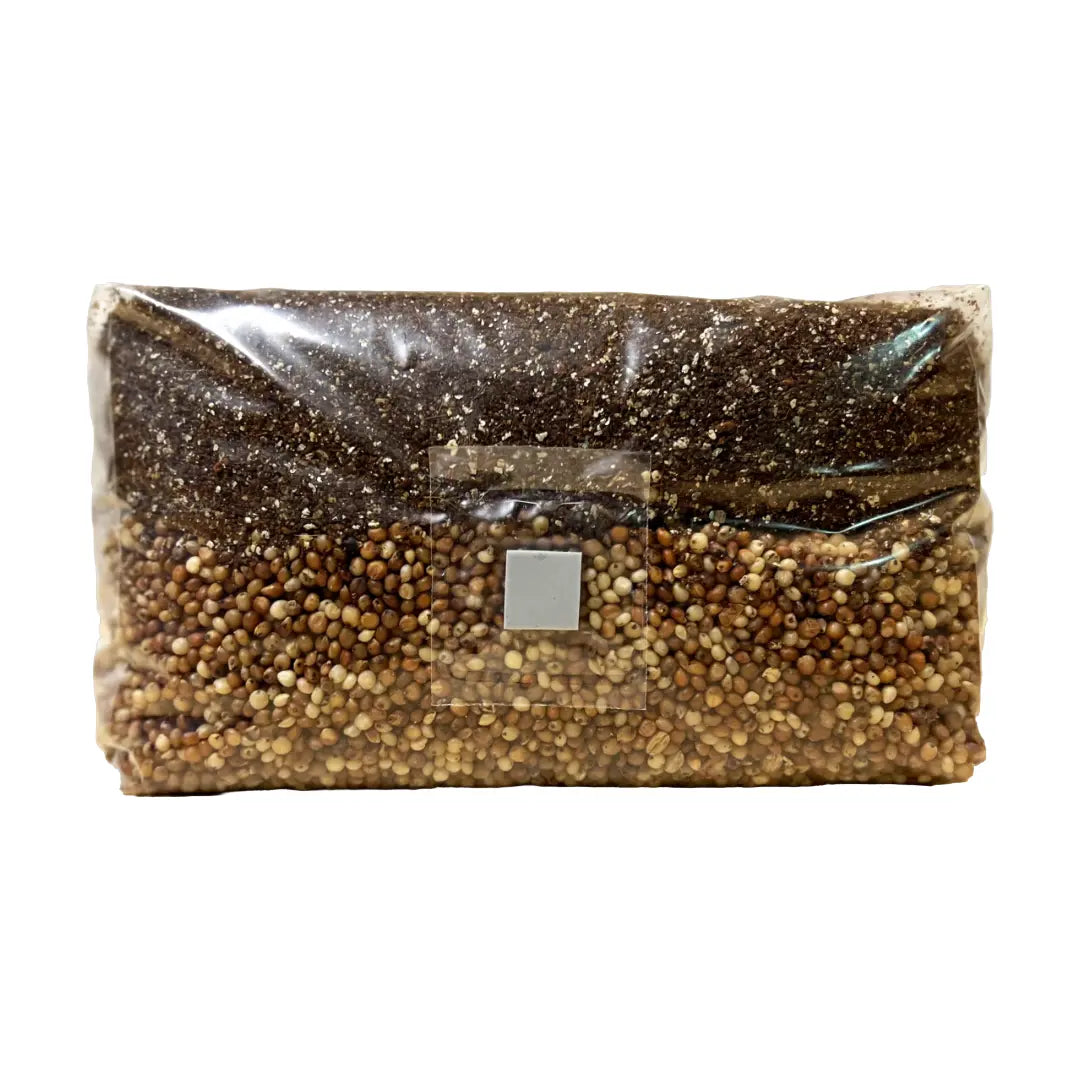⬇️ Prefer to listen instead? ⬇️
- Project-based mushroom farming helps kids learn more in science, tech, engineering, and math.
- Oyster mushrooms are good for kids because they grow fast, aren't toxic, and look interesting.
- Home mushroom kits help teach kids about being sustainable early on.
- Journaling during mushroom growing helps kids notice more, read and write better, and think hard about things.
- Cooking picked mushrooms shows kids how to eat healthy and learn about food science.
Mushroom growing kits are popular in homes and classrooms. They mix science, healthy eating, helping the environment, and fun into one activity. These kits are good for families and teachers. They are ready to use and offer a safe, fun way to get into the world of fungi. Kids get to try out farming, biology, and sustainability. Whether you homeschool or just want something to do besides screens on the weekend, growing mushrooms with a kit is an easy way to start. It can also start learning, creativity, and confidence in young growers. Our beginner-friendly mushroom grow kits are perfect for kids and families, offering a safe, hands-on way to learn, explore nature, and enjoy fresh mushrooms at home.

Are Mushroom Kits Safe for Kids?
Yes, mushroom growing kits are usually very safe for kids to use with just a little help. This is true especially when you buy kits from good companies. Most kits you can buy are made for beginners and families. They use substrate (the stuff mushrooms grow on) that already has spores. They use mushroom types that are not harmful, like oyster mushrooms (Pleurotus ostreatus). These are okay to eat and safe for even small kids to touch. These kits are small, clean, and don't need soil. This means less chance of getting exposed to dangerous germs.
But, adults still need to watch, especially at the start and when it's time to pick and cook the mushrooms. Wild mushrooms can look like the ones you can eat, but aren't safe. It's key to teach kids never to eat mushrooms not grown in the kit, and never without an adult saying it's okay. Also, mushrooms make spores that float in the air. So, it helps to grow the kits where there is good airflow. And tell kids not to sniff the kit up close.
For added safety:
- Use kits labeled "non-toxic" and "food-grade."
- Wash hands after handling the kit.
- Keep pets and very young children from tampering with the setup.
With the right help, growing mushrooms is safe. It's also calming and teaches kids things. It helps them learn by doing and encourages healthy habits.

What Age Is Appropriate to Start Growing Mushrooms?
Kids as young as three or four can help grow mushrooms. It's an experience rich in different feelings and textures, and an adult should guide them. Young kids like touching the cool substrate. They also like seeing the mushrooms change as they grow. For kids this young, just focus on keeping them interested, not on making them responsible.
When kids get to elementary school (ages 6–11), they can follow simple steps. They can use spray bottles the right way and watch how things change over days. This is a good time to start mushroom journals, photo logs, and daily jobs like spraying water or checking how much water is in the air.
Middle school and high school students (ages 12 and up) can do the whole project on their own. They can look more closely at the science of growing mushrooms at home. They can study mycology (the study of fungi), how nature's systems work, fungal biology, and even plan their own tests. These tests can show how growth changes with different light, moisture, and heat.
Making the activity fit the child's age helps kids of all ages have a good time growing mushrooms. It makes sure the experience is right for them.

Mushroom Growing Kits as a Hands-On Science Experiment
Not many science projects you do at home are as lively and rewarding as a mushroom growing kit. Seeds can take weeks to sprout, but mushrooms grow fast. Sometimes they show up overnight. This fast growth is good for a child's short attention span. It also gives them the quick reward that keeps them interested.
Learning science by doing projects helps kids learn a lot. This is true in areas like biology, ecology, and how to think like a scientist. Growing mushrooms fits in many parts of science, tech, engineering, and math:
- Biology: Observe how fungi differ from plants and animals.
- Ecology: Learn how fungi help break things down and put nutrients back into the soil.
- Chemistry: See how moisture, pH levels, and heat affect how things grow.
- Engineering: Make the best place for the mushrooms to grow.
- Data Analysis: Measure how much they grow, keep track of the heat, and see patterns.
Kids see for themselves how nature reuses nutrients by breaking things down. The white filaments—mycelium—act like roots. The mushrooms grow up, ready to let out spores to make more mushrooms. It shows how life cycles work and how living things connect.
Older kids and teens who like science fairs or homeschool projects can get a lot from growing mushrooms. It's a good way to try experiments and learn more.

Creating a Mushroom Observation Journal
Start something fun that helps with reading, writing, and thinking by making a mushroom observation journal. Give your child a notebook just for their mushroom growing. This helps them think about what they are doing regularly. It can also make them feel more like it's their project.
Here are ways to set up a simple observation journal:
- Daily Sketching: Draw pictures of growing mushrooms, keeping track of size or color changes.
- Growth Logs: Measure how tall and wide the mushrooms are each day.
- Sensory Notes: Write down what they smell, feel, and look like.
- Hypotheses and Conclusions: Guess what might happen next and think about how things turned out.
- Photo Additions: Tape in printed photos or draw pictures that show growth over time.
Here are some questions to help them wonder:
- “Compare today to yesterday—what’s different?”
- “Where do you see the most growth?”
- “What questions do you have about what’s happening?”
Besides science, journaling helps kids notice more, learn new words, think carefully, and be patient. These are skills they can use in any school subject.

Cooking with Mushrooms: Involve the Little Chefs
When the mushrooms are grown, you can teach kids about getting food ready and eating healthy. This is a fun chance to do that. Cooking helps kids use what they grew in their science project. They can turn it into a healthy, good-tasting meal. This shows them how science is part of daily life. It's also a great time to show where food comes from. This is a key part of learning about healthy eating and the environment.
According to the USDA (2022), mushrooms are good for your health in many ways. They don't have much fat or calories. They have a lot of selenium and vitamin D. And they give you fiber and antioxidants.
Fun recipes for kids include:
- Mini Mushroom Pizzas: Use English muffins for the base and cooked mushrooms on top.
- Mushroom Quesadillas: Soft tortillas filled with cheese and cut-up mushrooms.
- Stuffed Mushrooms: Mix breadcrumbs, cheese, and herbs for a warm snack that tastes good.
Let kids wash, chop (with help), measure how much of things to use, and set timers. Cooking helps build math skills, clean habits, and even working together.
If your child doesn't want to eat the mushrooms, let them make up their own recipe. They will likely try it if they helped make it.

Mushroom Spore Print Art & Other Fungi Crafts
Mushroom projects don’t stop at dinner. Use the mushroom caps left over to make spore prints. This is a pretty art form from nature. It also shows how fungi make more of themselves.
To make one:
- Take off the stem of a mushroom that is ready.
- Put the cap gill-side-down on white or black paper.
- Cover it with a glass bowl or cup and leave it for 12–24 hours.
- Take off the cap to see the pattern left by the spores that fell.
These prints look like fireworks or mandalas—and no two are alike! Kids can frame them, put them into artwork, or use them for school.
Other crafts you can do:
- Make Your Own Mushroom: Use clay or paper-mâché to shape fun, made-up mushrooms.
- Felt Mushroom Sewing: A gentle way to learn how to use a needle.
- Map of Mushroom Adventures: Draw where mushrooms live around the world. Look up real types of mushrooms from those places.
- Creative Writing: Finish the story prompt, “One day I shrank and found myself in a mushroom forest…”
Adding art to kids mushroom growing helps them pay attention to small things. It also celebrates how beautiful nature is.

Teaching About Being Sustainable By Growing Mushrooms
Growing mushrooms at home teaches kids about being sustainable. It's something they can see and touch, and it makes them feel they can help. Mushroom kits help kids see how important it is to "close the loop" with food. This means turning waste from farms, like sawdust or coffee grounds, into food that is good for you.
The Environmental Protection Agency (2021) points out that making compost and growing food at home helps cut down on methane gas from trash dumps. It also helps manage materials in a way that is better for the planet. Kids learn that fungi are main helpers in breaking things down. They break apart stuff, feed plants, and make the soil healthier.
Things to do to teach about being sustainable:
- Collect clean cardboard or paper waste to add to the growing stuff.
- Compare mushrooms from the store to ones grown at home. Think about the packaging and how it affects the air.
- Think of other foods or things that could follow a sustainable cycle.
In the end, kids see themselves not just learning, but helping the planet stay healthy.

Keeping the Kit Healthy and Taking Care: Teaching Kids to Be Responsible
One good thing about mushroom growing kits that people don't always notice is how they help kids get used to a routine and be responsible. These kits do best when you do things regularly. Spraying a little water, letting air flow, and picking when ready are all key.
Give your child jobs like:
- Spraying a light mist 2–3 times per day
- Writing down growth in their observation journal
- Checking the heat and moisture in the air (with a thermometer/hygrometer)
- Gently picking grown mushrooms with clean hands or scissors
Doing these jobs is like a small example of managing time and taking care of something. If they forget to spray or wait too long to pick, they might get fewer mushrooms. This shows them in a real way that doing things when needed is important. It helps them learn to be responsible and that trying hard all the time matters.
Saying "good job" when they do well also helps them feel more sure of themselves. Celebrate when they do something good, like “First Mushroom Grown” or “Harvest Day.” You can use stickers, certificates, or a special meal with mushrooms.

Top Mushrooms to Grow at Home with Children
The kind of mushroom you grow changes what the whole experience is like. For kids, pick mushrooms that have bright colors, grow fast, and don't mind small mistakes.
Here are the top choices for people just starting:
- Oyster Mushrooms (Pleurotus ostreatus): We really suggest these. They grow super fast (7 to 10 days). They come in bright colors like pink, yellow, and blue. And they look cool as they grow, which is fun for kids.
- Lion’s Mane (Hericium erinaceus): These are fluffy and look like snowballs. They are fun to look at and taste mild when you cook them.
- Golden Oyster: This one is bright in color and grows in groups. It looks neat.
- Chestnut Mushrooms: They look and taste earthy. They take a bit longer to grow, but older kids can still do them.
Don't pick button or portobellos if you are just starting. They grow slower, need more specific conditions, and often need extra layers or more careful cleaning before you start.

Choosing the Right Mushroom Kit for Kids
There are many kits to choose from. Picking the right one can seem like a lot. Look for kits made for people just starting or for teaching. Things to look for include:
- Substrate with spores already in it: This makes setting up easier. You don't have to handle spores, which might be too much or messy for kids.
- Clear Instructions: Look for kits with step-by-step guides that kids can follow, pictures, or codes you scan for videos.
- Grows Fast: 7–14 days helps keep younger kids interested.
Some better kits have:
- Tents that keep the air moist
- Growing boxes that look like logs or animals
- Journal tools or sheets included
Add things to the kit to make it better. You could add books about fungi, safety scissors for picking, or kitchen tools. This makes it a project that pulls you in.

What Supplies You Might Need Beyond the Kit
Most mushroom growing kits you buy have everything you need inside. But adding more tools can make learning even better:
- Spray Bottle: One sized for a child is easier for them to hold and use.
- Moisture and Heat Meter: Helps them collect facts and look at their growing space.
- Magnifying Glass: Helps them look really closely at the mycelium (the white stuff) and spores.
- Notebook: Helps them build a routine and stay interested over time.
- Art Supplies: Markers, colored pencils, stickers—these are good for keeping track, making notebooks look nice, and celebrating when they reach a goal.
Tell your kids to take a photo of the mushroom each day. They can make a slideshow that shows it growing over time or put the photos in a scrapbook. It’s fun, creative, and keeps a record for science.

Things That Might Go Wrong (and How to Learn From Them)
It's good that things might not go perfectly when kids grow mushrooms. It's okay when that happens. Mistakes turn into good times for learning.
Here are things that often happen and how you can use them to teach:
- Too Much Water: Mushrooms like the air to be moist, but not the block to be wet. Teach children to feel the block before spraying.
- Not Enough Water: Check how dry it is by touching and looking. If the block is dry, the mushrooms might stop growing.
- Not Enough Airflow: Mushrooms need air moving around. Teach kids to check if the air feels still.
- Picking Too Soon: Waiting helps kids learn to be patient.
- Wait for mushrooms to get twice as big overnight. That's the best time to pick them.
Instead of calling them failures, call them "fungi facts" or say things like, “Now we know!” Talking about it or writing in a journal helps kids think like scientists and figure out how to fix problems.
Mushroom growing kits are more than just something to look at on the windowsill. They are bright, living tools for learning. They bring science, being responsible, helping the planet, art, and healthy eating together. It's an activity anyone can do. They also help kids see how nature and daily life are linked. And maybe they will get interested in biology, farming, or ecology for their whole life.
So maybe you are making a lesson plan, or you want a weekend project that is good for the planet. Or maybe you just want to grow more than mushrooms at home. Whatever the reason, let your kids get into the fungi fun.
Citations:
- Environmental Protection Agency. (2021). Sustainable materials management: Composting and food waste. https://www.epa.gov/smm/composting-and-organics
- U.S. Department of Agriculture. (2022). Nutrition facts for mushrooms. https://fdc.nal.usda.gov/fdc-app.html#/food-details/168478/nutrients



